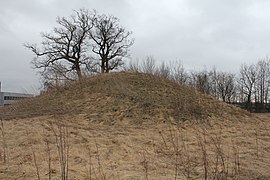Snail hill
A snail mound ( Danish sneglehøj ) is a burial mound with a surrounding upward path or processional path. The locally widespread phenomenon ( Zealand and Møn ) is limited to round mounds without a burial chamber, originally with a stone on top of the hill. Sneglehøj is a local name that is not necessarily used officially. A survey found that nine Danish hills from the older and younger Bronze Age are known locally as Sneglehøj. Since thousands of burial mounds have disappeared or the path has been removed, it can be assumed that snail mounds were more common.
description
Snail hills were not systematically recorded as such and are only mentioned occasionally in official descriptions. This may be due to authoritative archaeologists viewing the phenomenon as a result of a later Romantic construction. This is apparently the case for hills in manor parks, but does not explain why subsequent generations should have had an interest in carrying out the rather extensive earthworks. The purpose of the evacuation is unknown, but is likely to be linked to religious rituals. The Sneglehøj on Møn is on the new 500 crowns displayed banknote.
- Snail hill
See also
literature
- Bent Gottfredsen: Om sneglehøje and other høje including lidt om tingsteder, kæmpekastede sten, jæ tter and andet troldtøj.



